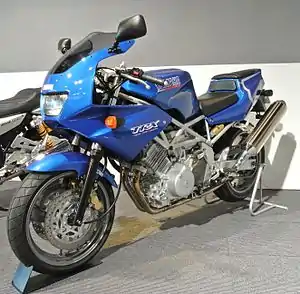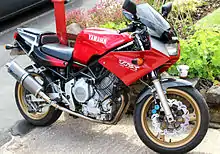Yamaha TRX850
The Yamaha TRX850 is a sports motorcycle with a 10-valve DOHC 849 cc 270° parallel-twin engine. First released in Japan in 1995, a version for the European market was available from 1996 to 2000.
 | |
| Manufacturer | Yamaha Motor Company |
|---|---|
| Also called | TRX |
| Parent company | Yamaha Corporation |
| Production | 1995 (Japan only) 1996–2000 [1][2] |
| Class | Sport bike |
| Engine | 849 cc liquid-cooled 4-stroke 10-valve DOHC crossplane parallel-twin |
| Bore / stroke | 89.5 mm × 67.5 mm (3.52 in × 2.66 in)[3] |
| Top speed | 135 mph (217 km/h)[1] |
| Power | 59 kW (79 hp) (claimed)[1][2] |
| Torque | 85 N⋅m (63 lb⋅ft) (claimed)[1] |
| Transmission | 5-speed constant-mesh |
| Wheelbase | 1,435 mm (56.5 in) |
| Dimensions | L: 2,070 mm (81 in) W: 700 mm (28 in) |
| Seat height | 795 mm (31.3 in) |
| Weight | 190 kg (418 lb) (dry) |
| Fuel capacity | 18 l (4.0 imp gal; 4.8 US gal) |
| Related | Yamaha TDM850 |
Design and development


The TRX has a half fairing, clip-on handlebars and mildly rear-set footrests. The front forks are conventional telescopics, and the rear suspension is a rising-rate monoshock unit. Effectively a factory-built café racer, there is meagre provision for a pillion passenger.[4]
The TRX engine was derived from that in the Yamaha TDM850, but the TRX is lighter, lower and sportier than its TDM stablemate. The parallel twin engine produces some 85 Nm of torque and 79 bhp. The engine has five valves per cylinder, three inlet and two exhaust; the inlets are 26mm the exhausts 28mm. Unusually for a dry sump design, the oil tank is not remote, but is integral to the engine, sitting atop the gearbox.[5] This feature simplifies manufacture, eradicates external oil lines, and gives faster oil warm-up. The shallow sump allows the engine to be sited lower, for an optimal CG position. The 360° crank of the original TDM was changed to a 270° crank in 1996, after which time the TRX and the TDM shared the same engine and transmission.[3][1] The engine has a balance shaft to smooth out residual vibrations.
In 2000 Yamaha stopped making the TRX, while the TDM series, enlarged to 900 cc, remained in production until 2011.[6]
Reception
The TRX was designed to compete in the market with the Ducati 900SS V-twin, whose tubular trellis frame it mimicked.[7] Although developed cheaply from Yamaha's "parts bin", using a TDM850 engine, the TRX performs well and has "a coherent identity of its own".[1]
In Motorcycle News (MCN) the TRX was later described as "the best-kept secret in motorcycling" and a "forgotten gem" which bore comparison with the 270° Norton Commando 961. The MCN review states: "The TRX produces less power than sports 600s of the same era, but it’s much gruntier and more satisfying to use thanks to that twin cylinder character".[1] The review added: "The TRX is a cracking bike, a sporty motorcycle with tons of character. It's stable, handles neutrally and feels like a proper sports bike".[1] In 2014, Steve Cooper wrote of the TRX: "Very much the thinking man's sports bike, this slightly oddball twin is beginning to reach cult status and for good reason; with a little work it's possible to see a genuine 100bhp...".[8]
Although considerably cheaper than the Ducati,[7] TRX sales were disappointing, and production ceased in 2000 with no obvious successor. MCN stated many years later in a review of the MZ 1000S, the most powerful production 180° crank parallel-twin: "As the Yamaha TRX850 demonstrated, many bikers aren't especially keen on parallel twins..."[9] That is now changing as costs are more important.[10] In recent years, being cheap we are seeing a rebirth of parallel twins, being so versatile and economical.[11] But as stated in a top 10 modern parallel twin review "They’re never going to be as popular as inline-fours, they’ll never be as iconic as a v-twin, and they’ll never have the exotic feel of a triple...".[12][10][11]
The 270° crankshaft
Although the 270° crank concept has been attributed to Australian Phil Irving (of Vincent renown),[8] the TRX was the first[13] production motorcycle to feature this innovation. The 270° crank has an ignition sequence and an engine balance that yields something of the feel of a V-twin. Unlike 180° & 360° parallel-twins, a 270° engine in motion never has both pistons stationary, so its flywheel momentum is continuous.[3] With less vibration than a 360° crank, and a more regular firing pattern than a 180° crank, a 270° crank results in a smoother engine. Any residual unevenness of the 270° firing interval has been claimed to deliver power to the rear tyre more effectively.[14]
Stuart Wood, Triumph’s chief engineer, declared that a 270° crank was ideal for large-capacity parallel twins, as it "generates fewer of those irritating high frequency secondary vibrations". [15] Since the TRX's demise, the 270° concept has emerged as a successful compromise for standard and cruiser motorcycles.[16] The parallel-twin layout is having something of a revival (the latest Honda Africa Twin is a 270° parallel-twin rather than the earlier V-twin incarnation). Manufacturers are even adopting the parallel-twin format for high-performance sportbikes, such as the (discontinued) MZ 1000S and the Métisse Mk5.[9][17][18]
References
- "YAMAHA TRX850 (1996-2000) Review". Motorcycle News. November 24, 2006. Retrieved November 5, 2016.
- "Yamaha TRX850 (1996 - 2000) review". Visor Down. Retrieved November 5, 2016.
- MacKellar, Colin (April 20, 1996). "Yamaha TRX 850". Motorcycle.com. Archived from the original on September 17, 2016. Retrieved November 27, 2016.
- An MCN review declared:"comfort’s not brilliant for the pillion".
- Note: some writers call a dry-sump system with no remote tank a "semi dry-sump".
- "Yamaha TDM900 (2002-current) - Yamaha Motorcycle Reviews". Motorcyclenews.com. Retrieved 2011-12-27.
- "Performance Bikes" - October 1996 - pp118-124
- Motorcycle Monthly, April 2014
- "MZ 1000S (2004-2007) Review". Motorcycle Newss. November 23, 2006. Retrieved April 23, 2017.
- Cameron, Kevin (December 3, 2015). "ASK KEVIN: Parallel Twin vs. V-Twin?". Cycle World. Retrieved November 19, 2017.
- Appleton, Joe (2017). "Parallel Universe: Top 10 Modern Parallel Twin Motorcycles!". Gearheads. Retrieved November 19, 2017.
- VisorDown report on 2018 bike trends
- "Fast Bike" magazine August 1995 page 20
- From a press release issued by Yamaha Motor Corp. U.S.A. (2008-09-08). "Updated: 2009 Yamaha YZF-R1 Features Uneven Firing Order For Improved Power Delivery News Article". Roadracingworld.com. Retrieved 2011-12-27.
- Motorcycle.com review
- Motor Cycle News 28 Sept 2011 page 4
- Dabbs, Chris (September 2010). "New rider: Parallel twins explained". Motorcycle News. Retrieved November 19, 2017.
- "Supersport", Honda, 2017, retrieved November 19, 2017
"Yamaha Supersport Motorcycles", Yamaha, 2017, retrieved November 19, 2017
"MOTORCYCLE", Kawasaki, 2017, retrieved November 19, 2017
"Sport", BMW, 2017, retrieved November 19, 2017
"Sportbike", Suzuki, 2017, retrieved November 19, 2017
"A New Opera", Ducati, 2017, retrieved November 19, 2017
"Roadster and Supersport", Triumph, 2017, retrieved November 19, 2017
"Aprilia - the Motorbikes", Aprilia, 2017, retrieved November 19, 2017
"KTM SUPERSPORT", KTM, 2017, retrieved November 19, 2017
"MODELS", MV Agusta, 2017, retrieved November 19, 2017